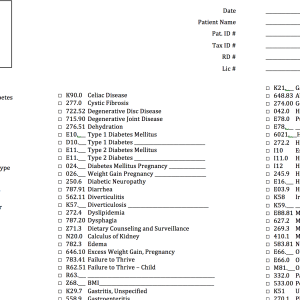Using the ICD-10 Codes
The ICD-10 codes are very different from the ICD-9 codes. There are many more codes because each diagnosis has numerous “modifiers”, also referred to as additional digits, to differentiate the nuances in each condition. For example, the code E10.__ has been defined as Type 1 diabetes mellitus, but we now have a list of 10 modifiers to further identify the diagnosis of diabetes mellitus. E10.2, for example, is the diagnosis for “Type 1 diabetes mellitus with kidney complications”.
This super-bill will list the diagnoses most likely to have nutrition implications, with a blank after the dot for the clinician to fill in the modifiers and in some cases a blank after the code to write in the specific diagnosis. Due to the sheer number of ICD-10 codes, it is not possible to fit them all on one page. Note it is not within the scope of practice for a registered dietitian/nutritionist (RDN) to make a medical diagnosis. The one exception is the BMI codes, as “they represent a mathematical calculation based on measurements that are within the RDNs scope of practice to perform.” (1) RDNs should obtain the additional digits from the physician/physician assistance office to accurately complete the super-bill.
We have provided you with each basic diagnosis code on the super-bill. Please refer to this list, provided by The Academy of Nutrition and Dietetics, for additional information on the additional digits: http://www.eatrightpro.org/~/media/eatrightpro%20files/practice/getting%20paid/icd-10-cm-codes-for-rdns.ashx
Remember, though, to consult with the referring physician’s office to obtain the additional digits. In addition, we have provided a link below to the full list of ICD-10 in the event that your desired code is not on our super-bill. (2)
Happy Coding!
Faye




